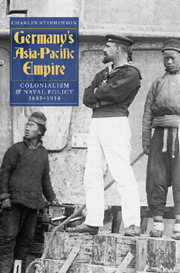Book contents
- Frontmatter
- Contents
- List of Illustrations
- List of Maps and Tables
- Introduction
- 1 Bismarck and Empire: 1885–1888. Kaiser Wilhelm's Land, the Bismarck Archipelago, the Marshall Islands and Nauru
- 2 The Acquisition of Kiautschou: 1897
- 3 China 1897–1914: Colonial Development and Political Turbulence
- 4 Tectonic Shift 1: 1898–1899. Spain and the USA, Germany, Micronesia and Samoa
- 5 Tectonic Shift 2: 1902–1914. Japan and Russia, Britain and Dominion Defence, the United States
- 6 War. August 1914
- 7 Naval Plans and Operations 1897–1914
- 8 Kiautschou: Naval and Military Operations 22 August–28 September 1914
- 9 Tsingtau: Naval and Military Operations 28 September–7 November 1914
- 10 Aftermath
- Notes to the Text
- Bibliography
- Index
5 - Tectonic Shift 2: 1902–1914. Japan and Russia, Britain and Dominion Defence, the United States
Published online by Cambridge University Press: 12 September 2012
- Frontmatter
- Contents
- List of Illustrations
- List of Maps and Tables
- Introduction
- 1 Bismarck and Empire: 1885–1888. Kaiser Wilhelm's Land, the Bismarck Archipelago, the Marshall Islands and Nauru
- 2 The Acquisition of Kiautschou: 1897
- 3 China 1897–1914: Colonial Development and Political Turbulence
- 4 Tectonic Shift 1: 1898–1899. Spain and the USA, Germany, Micronesia and Samoa
- 5 Tectonic Shift 2: 1902–1914. Japan and Russia, Britain and Dominion Defence, the United States
- 6 War. August 1914
- 7 Naval Plans and Operations 1897–1914
- 8 Kiautschou: Naval and Military Operations 22 August–28 September 1914
- 9 Tsingtau: Naval and Military Operations 28 September–7 November 1914
- 10 Aftermath
- Notes to the Text
- Bibliography
- Index
Summary
On 12 February 1902 it was announced, simultaneously, in the United Kingdom and Japan that a treaty of alliance existed between the two states. This, the Anglo-Japanese Alliance of 1902, had actually been signed on 30 January but had not been publicly announced so that the ‘Great Powers’ of Germany, Russia and France could be informed. These were the same powers that had, in 1896, formed the so-called Triple Intervention, or Dreibund, that forced Japan to give up the Liaotung Peninsula along with Port Arthur; which territory had been taken from China under the Treaty of Shimonoseki following Japanese victory in the Sino-Japanese War of 1894–95. The United States was also, though later, informed prior to the alliance being made public.
Both parties embarked on the alliance out of self-interest and as a measure to counter prospective and real Russian expansionism, which Germany and Austria-Hungary sought to divert, for obvious reasons, towards Asia, or at least had actively under Bismarck; his successors were not so astute. This in turn meant potential conflict with Britain across the Raj's northern borders, particularly in Afghanistan, and with Japan, particularly in Manchuria and Korea.
The British Admiralty, at the time under the political leadership of William Waldegrave Palmer, the 2nd Earl of Selborne, First Lord of the Admiralty 1900–05 and son-in-law of the Prime Minister, the 3rd Marquess of Salisbury, was keen on the alliance, not least for reasons of economy.
- Type
- Chapter
- Information
- Germany's Asia-Pacific EmpireColonialism and Naval Policy, 1885–1914, pp. 67 - 84Publisher: Boydell & BrewerPrint publication year: 2009



